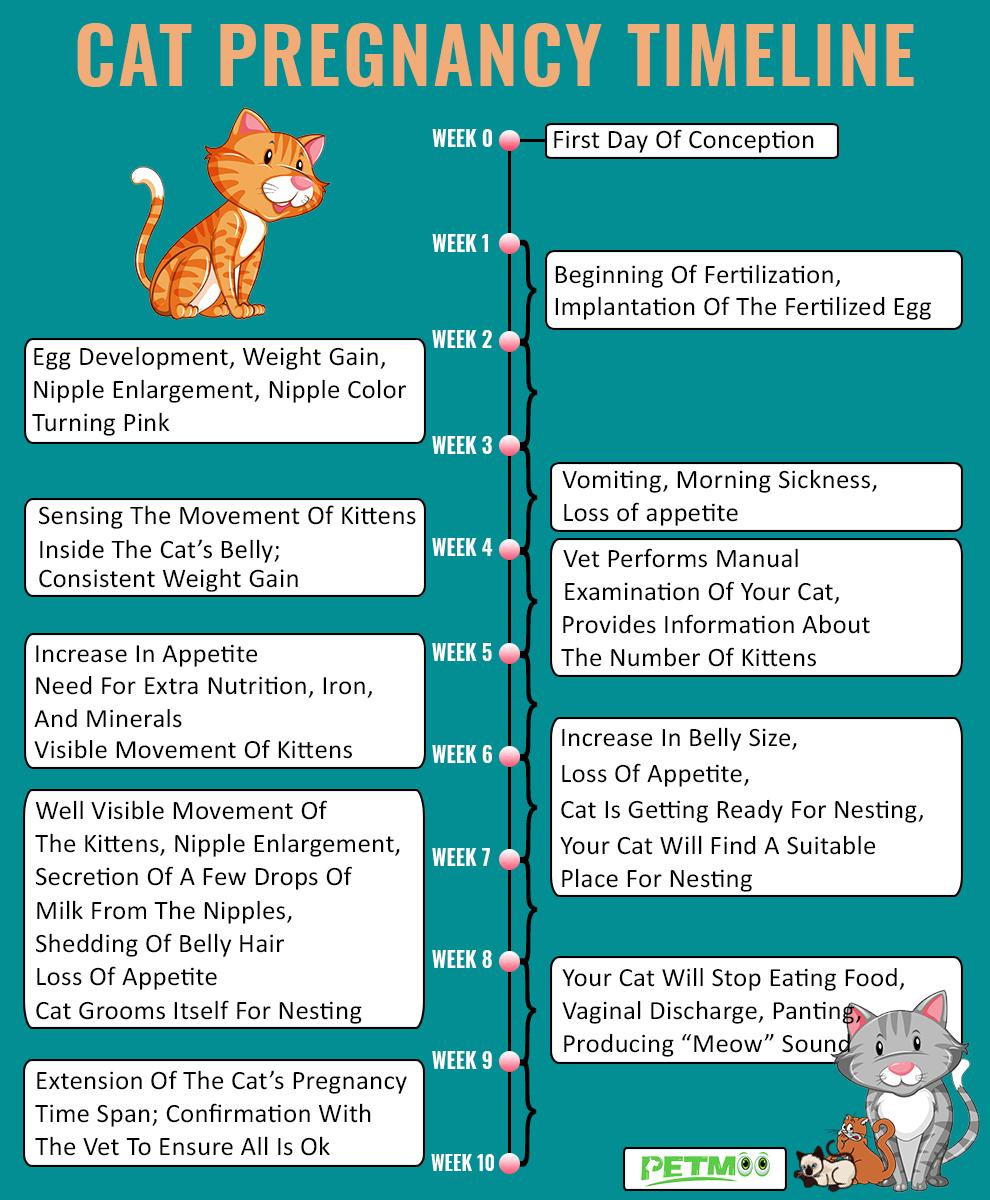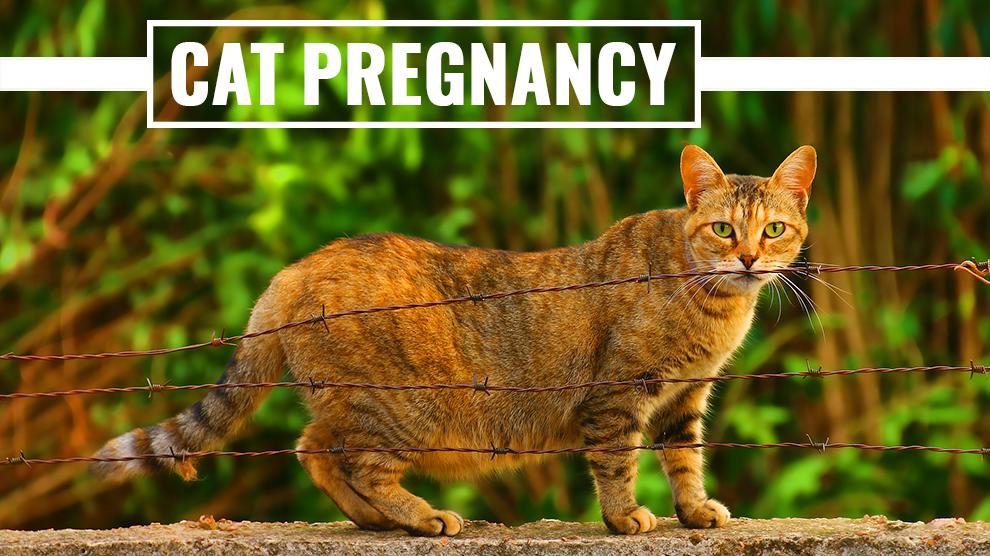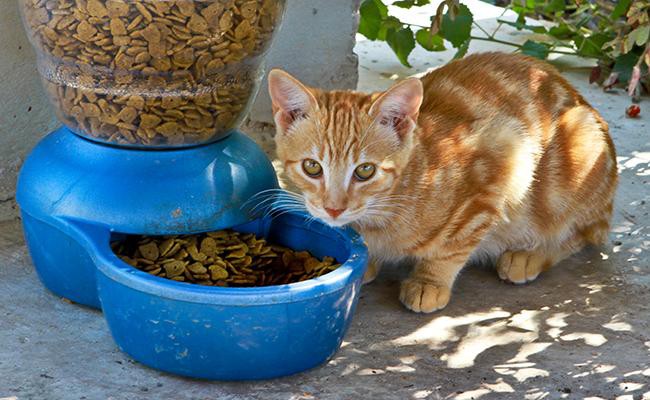Cat Pregnancy Calculator And Timeline
Is your cat on the way to bringing a few more special additions to your family? Then, it will be a happy and hectic time for you and your feline.
Kittens are cute, adorable creatures in a way one’s heart will melt. Hope yours too! So, welcoming new bundles of joy is the one that cannot be described in words for you as a feline owner.
But, have you made all the arrangements for your queen? If not yet, then wait! You need to know quite a lot of things about cat pregnancy.
In this article, we will discuss identifying pregnancy in cats, the nutritional requirements during gestation, how to care for your queen, and how to make queening a comfortable and wonderful experience for her.
How Do I Know If My Cat Is Pregnant?
You will be curious to know whether your feline is pregnant, especially if you are a breeder. So, let’s take a look at the ways to identify this exciting news.
Cat Pregnancy Signs
Your pregnant queen will tell you the good news through a few signs.
Morning sickness – Like humans, she will experience morning sickness. Your feline will be vomiting while she is pregnant. But if you notice frequent vomiting, it is better to consult the vet.
Enlarged nipples – You can notice that your feline’s nipples will become larger and red around days 15 to 18 of gestation. The enlargement and red coloring of the nipples are usually called pinking up.
Increased appetite – She will eat more than usual while completing at least half of the gestation period.
Weight gain – It is a positive and strong sign that your feline is pregnant. Your queen will gain weight around 1 to 2 kg normally. But, its weight will also depend on the number of kittens she carries.
Swollen belly (3rd to 4th week) – Your cutie pie will show her belly during pregnancy. So, you should avoid touching the swollen belly as it may hurt the momma cat and the unborn kittens.
Seeking extra attention – She will act more maternal, like pursuing more and seeking extra attention and fussing from you.
Cat Pregnancy Test
If you suspect that your feline is pregnant, you can detect the same through test kits. These kits will detect the presence of “relaxing,” a hormone present in cats during pregnancy, 20 to 25 days after insemination.
To use these kits at home, you have to draw a drop of blood from your queen. Then, process the blood using a centrifuge and use the same in the test kit to detect the pregnancy.
Although you can detect your feline’s pregnancy at home, it is always the best way to confirm the same with the vet.
Your cat may also have increased appetite and swollen belly due to worms or any other illness. So, take her to the vet 3 weeks after conception and confirm pregnancy.
The vet will confirm the kittens that are on the way either through ultrasound examination or X-rays. He will also tell you about the number of kittens.
How Long Is A Cat Pregnant?
Next to the overwhelming news, the most curious thing for you is to know about your tabby’s pregnancy time span. Also, this information is the one that you should know as a breeder.
But do you think that humans and cats have the same pregnancy period? Actually, no, but the count is the same. That is, cats are pregnant for ¼th of the human gestation period.
Does this mean cats have to short gestation period? Of course, yes! Your queen will be pregnant for 9 weeks (instead of 10 months like humans), and sometimes, this period may extend up to 10 weeks.
Common, let’s see about your queen’s actual gestation period.
Gestational Period For Cats
If you know the term “Pregnancy,” you must also know the term “Gestation Period.” It is the number of days between your queen’s mating date and the birth date (or the expected date) of your kittens.
As discussed earlier, cats have a shorter gestation period. That is, the gestation period of a feline usually ranges from 63 to 67 days. But, this may vary by a few days depending upon the time your cat goes into labor.
But, this may vary by a few days depending upon the time your cat goes into labor.
If you want to know what will happen to your queen during the gestational period, the timeline chart will help you.
The cat pregnancy timeline will give you complete information about the week-by-week developmental changes.
Cat Pregnancy Timeline
Are you excited to know about the developmental stages of your tabby’s pregnancy? We will make you feel amazing by providing a week-by-week cat pregnancy timeline with pictures.

A cat’s pregnancy span is of 9 weeks, sometimes may extend up to 10 weeks. So, kittens will have rapid growth that you can see with your naked eyes from the 4th week onwards.
Weeks 1 to 2: At week 0 or 1, the overwhelming period, the fertilization time, starts for your tabby. Implantation of the fertilized eggs will happen on day 10 of pregnancy. Your cat will have no symptoms at this week of pregnancy.
Weeks2 to 3: The eggs will start to develop further. Your cat will slowly start to show symptoms such as weight gain and nipple enlargement. The color of the nipples will become pink as well.
Weeks 3 to4: During this time span, your cat will show the early signs of pregnancy. That is vomiting, morning sickness and loss of appetite, etc. At the end of the 4th week, you can feel the kittens’ presence in the cat’s belly by simply touching it. Your tabby’s body weight will continue to increase.
Weeks 4 to 5: The vet will perform the manual examination and may even provide information about the number of kittens present in the cat’s body.
Weeks 5 to 6: Your cat’s need for appetite increase further during this time span. It needs extra nutrition to keep her healthy. So, provide extra minerals and iron to your tabby for the kitten’s health. You can also see the movement of kittens from outside.
Weeks 6 to 7: Your tabby’s belly size increases so that it will become large and round. So, the cat will get ready for nesting and may not feel hungry. As it feels to nest, it will choose a suitable place to give birth to the kittens.
Weeks 7 to 8: The movement of kittens inside the cat’s body will be well visible to your eyes. The cat’s nipples will enlarge. Further, its belly hair will shed, and a little amount of milk will be secreted from its nipples. It may lose the appetite, and totally your cat grooms itself for delivery.
Weeks 8 to 9: This time period is the exact labor week that is nesting. Around 63 to 65 days of gestation, your cat may stop eating the food as the kittens are on the way. It will have a vaginal discharge, and it may pant and meow as well.
Sometimes, your tabby’s pregnancy may extend up to the 10th week. So, contact the vet to make sure that everything is fine.
Cat Pregnancy Calculator
Feeling happy about the kittens, you will be eager to know the actual due date. As the average pregnancy period for your feline is 65 days, you may be counting the due date with your fingers or by seeing the monthly calendar.
But, online tools will reduce your time by telling about the welcome party date (i.e., due date) of your queen’s kittens. These tools either need the first day of breeding or the first day of conception.
Most of the tools will consider the average days of gestation as 63 or 65 and calculate the results.
Pregnant Cat Care
It is essential to take care of your queen with complete care during gestation. Caring involves the nutritional requirements, exercise and grooming needs, and regular veterinary checkups.
Pregnant Cat Food
As the cat can have an average number of 4 kittens, she will definitely need extra calories when she is expecting. Your queen will eat 1.5 times more than her normal diet while she is nearing delivery.
Also, your pregnant queen needs extra protein, energy, and calcium to cope with physical stress.
The food consumption of your feline may also vary throughout gestation. So, you can notice a slow and steady increase in her body weight and a gradual increase in food intake, especially during weeks 7 to 9.
Therefore, it is crucial to know about the nutritional needs and the things to ensure at each stage of pregnancy.
First, let’s get an idea about what to feed your queen during pregnancy.
- High-quality food – Feed a high-quality food for cats approved by the Association of American Feed Control Officials (AAFCO).
- Supplement “Taurine” – Ensure that foods to your feline should have the supplement “taurine” as taurine deficiencies may lead to fetal abnormalities or even death in cats.
- Canned foods – These foods will help your feline get enough calories, particularly during the later stage of pregnancy. These foods should be given as a supplement with the kitten food.
- Kitten food – You have to switch from normal foods to premium-quality kitten foods during the later pregnancy stage (i.e., last 3 weeks). Also, you have to continue this food until nursing and weaning.
- Oily fish – If your feline experiences constipation, give her oily fish such as sardines or tuna occasionally. You can also give her a mild herbal remedy to relieve her from constipation. But, ensure to consult the vet before giving these herbal remedies to her.
It is also essential to know the important things to ensure while feeding your cat during gestation. Here’re a few.
- Ensure that foods are available when she is hungry and feed water always.
- Your cat may eat less, eat more, or do not eat at all during pregnancy due to hormonal and behavioral changes. But, if your queen has these changes often and her health deteriorates, it is better to consult the vet.
- As food cravings are natural during pregnancy, your cat may also eat dirt. In such cases, you have to check with the vet and confirm if your feline is either having the condition “pica” or a nutrition imbalance.
Veterinary care
As pregnancy is the crucial period for your queen, it is essential to take your cat to the vet for regular checkups. Going to the vet regularly will help to know any health issues beforehand and to prevent them.
So, we have given a few things to ensure while providing veterinary care for your queen.
- If you are a cat breeder or have welcomed a stray cat to your home, take her to the vet for “well-check” as soon as you know the good news.
- Feline leukemia virus and feline immunodeficiency virus are harmful parasites. So, it is essential to discuss with the vet the pros and cons of vaccinating during gestation.
- It is also necessary to consult the vet about the proper treatment for worms and fleas present in your queen’s body.
- Generally, Vaccinations are not recommended during pregnancy because they might harm the kittens’ development.
Grooming
Your queen still needs grooming. But, she cannot clean all the areas herself at the later stages of gestation due to her bulky body. So, it would be best if you groomed her with utmost care.
A shortlist of grooming tips for your queen:
- At week 8, check her anal area daily and keep it clean. You can also use a sponge with mild soap and warm water or a kitty wipe and then using the tissues to dry the area.
- If she is having trouble with grooming, use a kitty wipe and gently groom her.
Exercise Needs
Ensure that she is doing exercises to stay healthy even at the later stages of gestation. But ensure that there is no hard play. Also, let your queen play regularly and gently.
Cat Labor
Your feline can handle labor herself. You should be prepared as a cat owner when she is nearing the end of the gestation period.
Your queen may also get complications during labor. So, your help is much needed during that time for your queen.
To be prepared beforehand and act accordingly, you must know that the signs of your queen going to labor.
Cat Labor Symptoms
You can know that your queen is going to deliver a kitten soon through a few signs. When you notice such signs, you should prepare all the arrangements for queening.
Pre Labor Signs in Cats
Your queen will show the below signs of labor (i.e., pre-labor signs) a week before it goes to labor.
- Visible nipples – Your queen’s nipples will be much visible, and you can even see a few milk drops on them.
- Nesting – She will start looking for warm and safe places to build a nest for her kittens.
- Refusing food – Your feline may refuse food, act restless, and look for a place to settle down before the labor starts. She will show this sign usually 2 days before going to labor.
- Drop-in body temperature – You can see a drop in her body temperature around 37.8°C, 12 to 24 hours before the labor starts.
It is essential to take your queen to the vet for the final prenatal visits in nesting mode. The vet will check the momma cat’s and kitties’ health and advise you about preparing for the delivery and what to do in case of an emergency during delivery.
Signs of Impending Labor in Cats
Although the feline shows some pre-labor signs, the below signs clearly indicate that she will go to labor in a matter of time.
- Abdominal contractions – This is an active sign of labor. Her abdomen will contract to push out the kitten from your queen’s belly.
- Vaginal discharge – Abdominal contractions are usually followed by vaginal discharge. This discharge is generally black and heavy, and the kittens will be born quickly after this discharge. But, if you find this discharge is blood in color, consult the vet as soon as possible.
- Vocal – Your queen will start licking her genitals and will be more vocal and nervous right before giving birth. She also wants to clean herself constantly.
Your queen will be anxious if she is delivering the first litter of kittens. Generally, she will give birth to the first kitten an hour after the labor starts. The next kittens will come every 15 to 20 minutes after the first one’s birth.
As a feline owner, you have to be careful about some labor complications such as discolored vaginal discharge and strain without kittens’ delivery. You should contact the vet for his immediate attention if you notice these complications in your queen.
Interrupted Labor
It is normally occurring in cats. If your queen stops straining, takes rest happily, and feeding the born kittens, although she still has to be born kittens in her belly, it is called interrupted labor.
Your cat will take food and drink and acts normal. In rare cases, your queen will deliberately delay or interrupt labor. She will be at this stage, even up to 36 hours. Then, she will normally deliver the waiting kittens with ease.
Queening Cat
When a momma cat gets ready to deliver the kittens, the process is called “queening.” Although your queen can manage labor herself, it’s your responsibility to make queening a comfortable and wonderful experience for her.
So, a few tips for you to make your home itself a comfortable place for delivering kittens. But it is not necessary that she has to choose your home. She may choose some other place, such as a laundry basket or the back of your closet, to give birth. In that case, let her do what she wants to do.
- To make your home a birthing spot for your queen, first, scan your home to choose a perfect place for her.
- If you have a medium-sized box with a low opening, cover it with newspapers, soft blankets, and old towels to create a relaxing area for the momma cat and her kittens.
- Then, place the box in a quiet corner of your home. Let your queen visit the box often to get used to it and feels comfortable before delivery.
- Once you notice the labor signs in her, stop letting her go outside normally.
Happy Queening!














